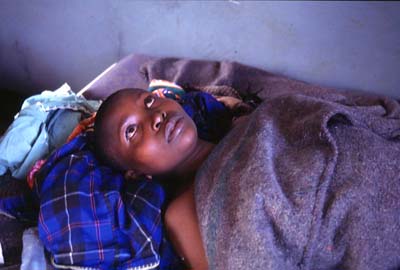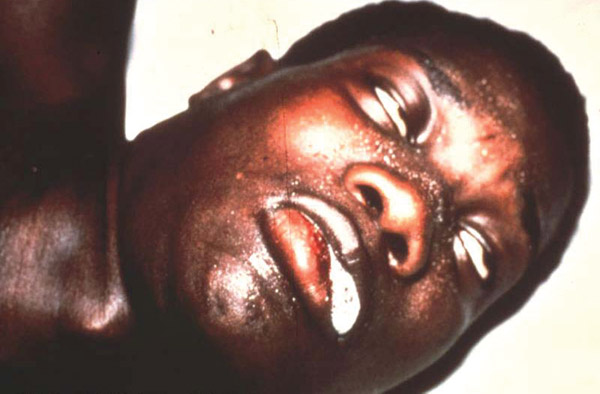 A young boy dying from the disease.
A young boy dying from the disease. This web page was produced as an assignment for an undergraduate course at Davidson College.
TREATMENT
 A young boy dying from the disease.
A young boy dying from the disease.
Unfortunately, the available treatments for African Sleeping Sickness are in short supply, difficult to administer and expensive. This is dreadful news to those living in poverty-striken Africa as without treatment, since the host's immune system cannot fight off or even actually detect the infection, the disease is lethal. Early detection and immediate treatment are the best courses of action currently available as the same variant protein coat that makes the parasite difficult for the immune system to detect invasion also prevents the construction of an effective vaccine. Unfortunately, diagnosis is also difficult seeing as there are actually two forms of the disease (T. b. rhodensiense and T. b. gambiense) and they are easily confused but require different forms of treatment. There are also two stages to each form of African Sleeping Sickness and once the patient has progressed to the second stage, there is very little that can be done to help them. The first stage is characterized by the hemolymphatic infection while the late stage begins with the onset of the infection of the central nervous system. With the decrease of treatment options as the disease moves into the second phase is a corresponding decrease in survival rates.
A man in the late stage of CNS damage. 
CURRENT MEDICATIONS
Suramin is admistered by a single weekly intravenous injection of l g for six weeks. Unfortunately, it is a very unpleasent drug. 90% of patients get a poison ivy-like rash and there is a 50% chance of adrenal cortical damage, which could be severe enough to require corticosteriod replacement for the remainder of the patient's life. Nausea and vomiting area also very common. More serious complications, such as kidney damage and exfoliative dermatitis, are more rare but still occur with alarming regularity.
Melarsoprol administration is even more unpleasant. Since it is an organic compound of the toxic element arsenic, it is a very risky choice. Also given via injection, melarsoprol causes wide spectrum of side effects. They range from the common rashes, nausea and vomiting to more serious reactions such as fever, loss of consciousness, fever and sometimes death. Known as "arsenic mixed with antifreeze" due to its chemical make up and disasterous effects on patients, this is normal reserved as the final option.
Originally designed to treat a very serious form of pneumonia known as Pneumocystis carinii (PCP), Pentamidine has been used to effectively treat African Sleeping Sickness as well. Also caused by a microscopic protozoa, PCP normally is found in immuno-compromised patients. Unfortunately, this drug has its own share of nasty side effects. Most commonly are sore throat, fever, unusual brusing or bleeding and decreased urination. More serious complications include heart problems, low or high blood sugar, low blood pressure, fast or irregular pulse. Less dangerous but equally as obnoxious are the two staples of nausea and vomiting.
Eflornithine is a newer and far safer alternative to the previously mentioned treatments. Unfortunately, due to its youth, the drug is still very expensive and its supply is limited. Currently, most hospitals rely on donations directly from the manufacturer for the small supplies they do have.